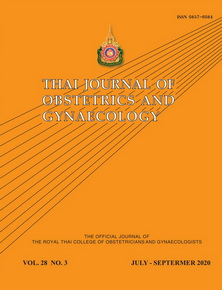Pre-implantation Genetic Testing for Aneuploidy (PGT-A)
Main Article Content
Abstract
Preimplantation genetic diagnosis (PGD) or embryo selection was first performed in 1989 using PCR for gender selection to avoid X-linked recessive disorder. However, there was a misdiagnosis due to allele drop out (ADO). Therefore, fluorescent in situ hybridization (FISH) was recommended for gender selection and detection of chromosome abnormalities and PCR was for monogenic disorders. Since then, a number of advanced modern analysis methods for preimplantation genetic testing (PGT) of chromosome balance were developed. A more sophisticating comparative genomic hybridization microarray (aCGH) was introduced in 2011 providing detailed copy number variation (CNV) of 24 types of chromosomes (22 pairs, X and Y). A single aCGH protocol was used for PGT of aneuploidy (PGT-A) and PGT of segmental rearrangement (PGT-SR) for every chromosome in one go. Next generation sequencing (NGS) replaced aCGH in 2015 due to its better resolution and lower cost. Single nucleotide polymorphism microarray (aSNP) with karyomapping analysis for simultaneous PGT of monogenic disorders (PGT-M) and PGT-A is still more expensive. In this article, various embryo biopsy and chromosome analysis techniques are discussed. The pros and the cons of each techniques are also included.
Article Details
References
Handyside AH, Kontogianni EH, Hardy K, Winston RM. Pregnancies from biopsied human preimplantation embryos sexed by Y-specific DNA amplification. Nature 1990;344:768-70.
Tongsong T, Wanapirak C, Sirivatanapa P, Sanguansermsri T, Sirichotiyakul S, Piyamongkol W, et al. Prenatal control of severe thalassaemia: Chiang Mai strategy. Prenat Diagn 2000;20:229-34.
Harper JC, Coonen E, Handyside AH, Winston RM, Hopman AH, Delhanty JD. Mosaicism of autosomes and sex chromosomes in morphologically normal, monospermic preimplantation human embryos. Prenat Diagn 1995;15:41-9.
Wells D, Delhanty JD. Comprehensive chromosomal analysis of human preimplantation embryos using whole genome amplification and single cell comparative genomic hybridization. Mol Hum Reprod 2000;6:1055-62.
Verlinsky Y, Cieslak J, Ivakhnenko V, Lifchez A, Strom C, Kuliev A. Birth of healthy children after preimplantation diagnosis of common aneuploidies by polar body fluorescent in situ hybridization analysis. Preimplantation Genetics Group. Fertil Steril 1996;66:126-9.
Munne S, Dailey T, Sultan KM, Grifo J, Cohen J. The use of first polar bodies for preimplantation diagnosis of aneuploidy. Hum Reprod 1995;10:1014-20.
Hardy K, Martin KL, Leese HJ, Winston RM, Handyside AH. Human preimplantation development in vitro is not adversely affected by biopsy at the 8-cell stage. Hum Reprod 1990;5:708-14.
Piyamongkol W, Bermudez MG, Harper JC, Wells D. Detailed investigation of factors influencing amplification efficiency and allele drop-out in single cell PCR: implications for preimplantation genetic diagnosis. Mol Hum Reprod 2003;9:411-20.
Veiga A, Sandalinas M, Benkhalifa M, Boada M, Carrera M, Santalo J, et al. Laser blastocyst biopsy for preimplantation diagnosis in the human. Zygote 1997;5:351-4.
Theobald R, SenGupta S, Harper J. The status of preimplantation genetic testing in the UK and USA. Hum Reprod 2020;35:986-98.
Palini S, Galluzzi L, De Stefani S, Bianchi M, Wells D, Magnani M, et al. Genomic DNA in human blastocoele fluid. Reprod Biomed Online 2013;26:603-10.
Findlay I, Ray P, Quirke P, Rutherford A, Lilford R. Allelic drop-out and preferential amplification in single cells and human blastomeres: implications for preimplantation diagnosis of sex and cystic fibrosis. Hum Reprod 1995;10:1609-18.
Griffin DK, Handyside AH, Harper JC, Wilton LJ, Atkinson G, Soussis I, et al. Clinical experience with preimplantation diagnosis of sex by dual fluorescent in situ hybridization. J Assist Reprod Genet 1994;11:132-43.
Colls P, Escudero T, Fischer J, Cekleniak NA, Ben-Ozer S, Meyer B, et al. Validation of array comparative genome hybridization for diagnosis of translocations in preimplantation human embryos. Reprod Biomed Online 2012;24:621-9.
Alfarawati S, Fragouli E, Colls P, Wells D. First births after preimplantation genetic diagnosis of structural chromosome abnormalities using comparative genomic hybridization and microarray analysis. Hum Reprod 2011;26:1560-74.
Handyside AH, Harton GL, Mariani B, Thornhill AR, Affara N, Shaw MA, et al. Karyomapping: a universal method for genome wide analysis of genetic disease based on mapping crossovers between parental haplotypes. J Med Genet 2010;47:651-8.
Natesan SA, Bladon AJ, Coskun S, Qubbaj W, Prates R, Munne S, et al. Genome-wide karyomapping accurately identifies the inheritance of single-gene defects in human preimplantation embryos in vitro. Genet Med 2014;16:838-45.
Natesan SA, Handyside AH, Thornhill AR, Ottolini CS, Sage K, Summers MC, et al. Live birth after PGD with confirmation by a comprehensive approach (karyomapping) for simultaneous detection of monogenic and chromosomal disorders. Reprod Biomed Online 2014;29:600-5.
Lukaszuk K, Pukszta S, Wells D, Cybulska C, Liss J, Plociennik L, et al. Routine use of next-generation sequencing for preimplantation genetic diagnosis of blastomeres obtained from embryos on day 3 in fresh in vitro fertilization cycles. Fertil Steril 2015;103:1031-6.
Stokowski R, Wang E, White K, Batey A, Jacobsson B, Brar H, et al. Clinical performance of non-invasive prenatal testing (NIPT) using targeted cell-free DNA analysis in maternal plasma with microarrays or next generation sequencing (NGS) is consistent across multiple controlled clinical studies. Prenat Diagn 2015;35:1243-6.
Munne S, Blazek J, Large M, Martinez-Ortiz PA, Nisson H, Liu E, et al. Detailed investigation into the cytogenetic constitution and pregnancy outcome of replacing mosaic blastocysts detected with the use of high-resolution next-generation sequencing. Fertil Steril 2017;108:62-71e8.
Twisk M, Mastenbroek S, van Wely M, Heineman MJ, Van der Veen F, Repping S. Preimplantation genetic screening for abnormal number of chromosomes (aneuploidies) in in vitro fertilisation or intracytoplasmic sperm injection. Cochrane Database Syst Rev 2006;1:CD005291.


